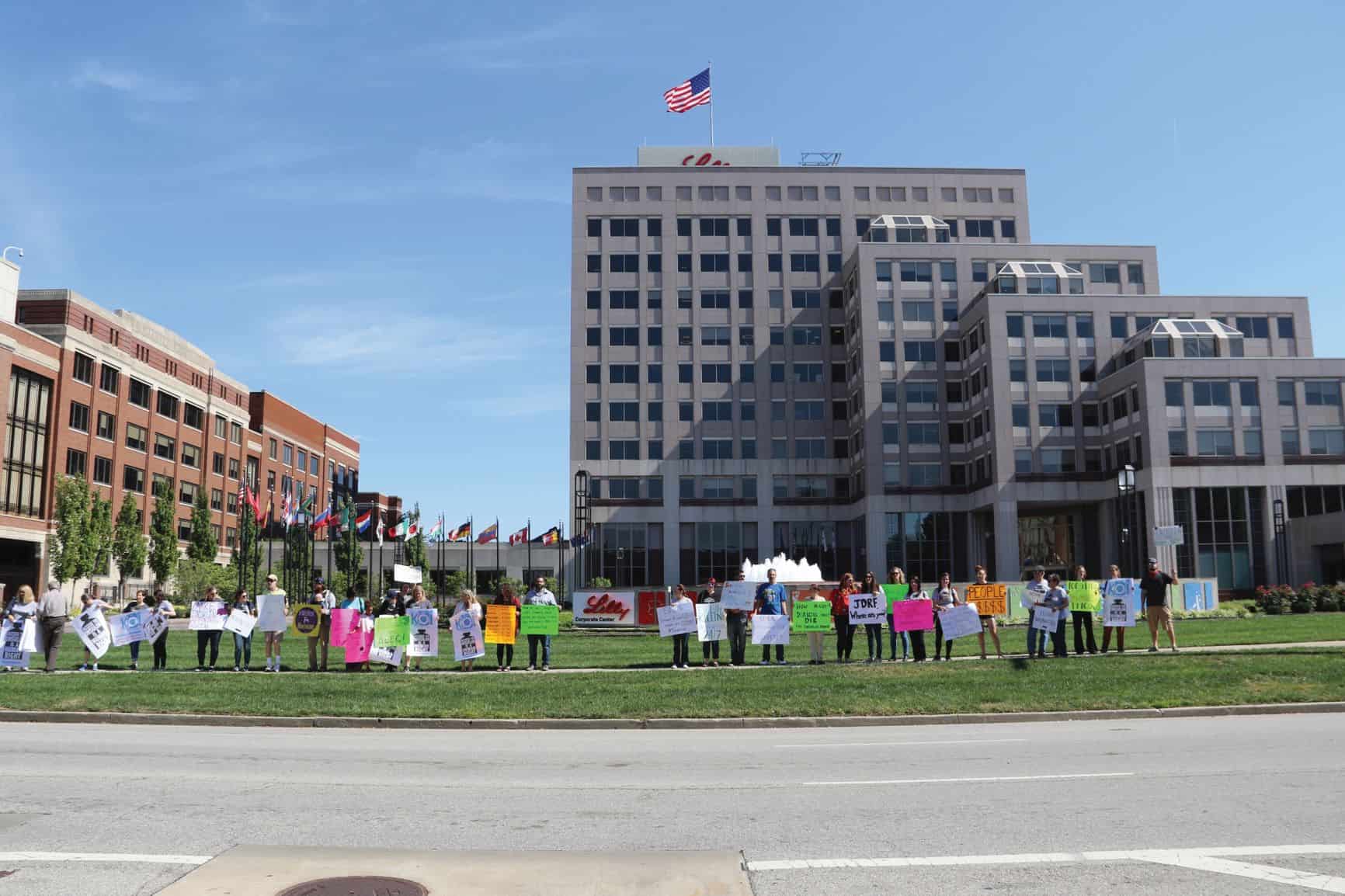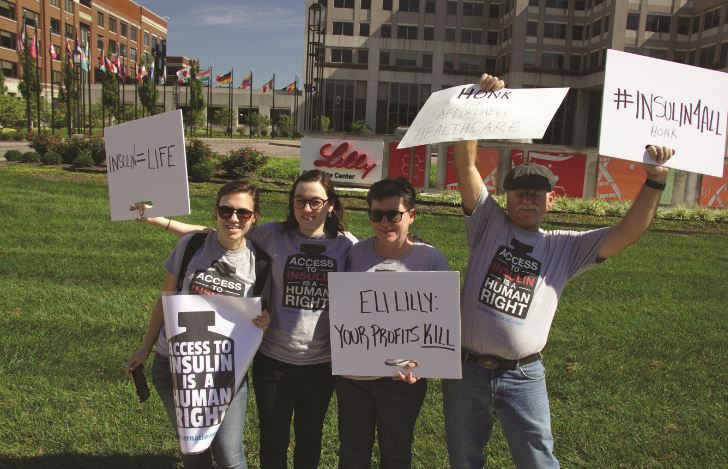
#insulin4all protestors outside Eli Lilly’s HQ in Indianopolis (Photos: T1International)
While access to insulin and its cost is rarely an issue in western Europe, it’s a huge problem in many developing countries, but also in the world’s richest – the US.
The reasons behind the problems in the US might be complex, but the facts are stark: the average wholesale price of four of the most popular insulins more than tripled between 2007 and 2017.
The monthly wholesale price of Humulin, the most popular insulin in type 2 patients, rose to nearly $1,100 between 2010 and 2015, up from $258 for the average patient. The price of Humalog, more commonly used by type 1 patients, also saw its price rise 585% from $35 to $234 between 2001 and 2015.
As many US patients have to contribute to their medication costs, the knock-on effect has been devastating: stories of individuals being forced to skip doses of insulin are legion, often resulting in life-altering complications and even death.
After years of steeply rising prices, the issue has hit the national consciousness in the US, and people with type 1 diabetes and their families are taking direct action and coming together to fix the problem themselves
T1International
Elizabeth Pfiester is the founder of T1International, an advocacy organisation aimed at helping people with type 1 diabetes worldwide overcome problems of access to affordable insulin supplies.

Elizabeth Pfiester (second left) and fellow protesters
The last few years have seen the T1International movement spread from state to state across the US, with activists accusing the big pharma insulin companies of greed and profits before patients, and attacking state and federal lawmakers for inaction in the face of a growing health crisis.
“Our advocates are truly fighting for their lives and their dignity. It’s as grass roots as you can get, and it has grown naturally,” says Elizabeth.
In April, in response to growing outrage over the problem (and the wider issue of rising drug prices), executives from pharma companies, pharmacy benefit managers (PBMs) and health insurers were hauled before Congressional inquiries to explain the increases and to offer some solutions.
The world’s three biggest insulin manufacturers are Novo Nordisk, Sanofi and Eli Lilly. The companies testified in Washington before the House Energy and Commerce oversight committee, but rejected suggestions that they were responsible for the price rises.
Instead, the companies pointed to the complexity of the US health insurance system, claiming it was ‘broken’ and that it was beyond their powers as individual companies to fix the affordability crisis.
This is an argument that Elizabeth and her fellow T1International activists wholeheartedly reject.
“It’s true that the US has one of the most complicated healthcare systems in the world and that is contributing to the problem.”
However she said this is an “easy way out, an easy excuse” for the pharma companies, and said a study by the Pew Research Center found that PBMs could only be blamed for a small proportion of the price increases.
“The pharma companies make massive profits from these products, billions of dollars.
“They could decide tomorrow that they can make insulin affordable – one company could become the game changer.”
The chairs of the oversight committee, Senators Chuck Grassley and Ron Wyden have vowed to pass legislation which will bring about a rapid drop in prices – but untangling the complexities of US healthcare and finding a bipartisan consensus are notoriously tricky.
Lilly’s authorised generic
One company, Eli Lilly, has responded to the pleas for more affordable insulins, and launched a half price ‘authorised generic’ version of Humalog in the US.
At the time, T1International welcomed the move as a step in the right direction, although it said the $137.35 price was still too high for many.
Lilly’s authorised generic product
However, Elizabeth said that since then type 1 patients have struggled to find supplies of the cut-price version, and believes that it is nothing more than a “PR move to say they’re doing something about the issue”.
A spokesman for Lilly told PME that access is ramping up since the authorised generic’s launch on 22 May, with 1,600 prescriptions filled across the US in the week ending 14 June.
The company commented: “We are focused on bringing down the cost people pay at the pharmacy. Today – thanks to a combination of insurance coverage and programmes that Lilly has introduced – 90% of people using Lilly insulin pay $50 or less for their monthly prescription, and 43% pay nothing (with 95% paying $95 or less).
“But we continue to advocate for public policy positions, such as the Rebate Rule proposed by HHS, that can help all people using insulin access it affordably.”
Elizabeth takes issues with many of Lilly’s access claims (and those of Sanofi and Novo Nordisk), which don’t tally with the experience of her organisation’s national network.
Dialogue with pharma? No thanks
As with the UK’s Cystic Fibrosis Buyers’ Club advocates, T1International doesn’t see dialogue with pharma as being worthwhile – after years of frustration and debates about policy, it would much rather take direct action.
This includes annual protests outside Lilly’s headquarters in Indianopolis, taking the form of #insulin4all vigils for the lives lost through patients having to miss insulin doses. Another initiative is a cross-border run into Canada by groups of type 1 patients, where insulin can be purchased at a tenth of the cost.
Where previous administrations were opposed to importation from Canada and elsewhere, the Trump White House says it is in favour of individuals resorting to these measures, but wants to legislate to find a long-term solution at home.
All of this points to pharma being cut out of the loop on the drive to find a solution to the crisis, with dire consequences for the companies’ reputations and businesses in the long term.
Elizabeth said T1Interational’s experience with talking to Lilly informed its view that there was little value in talking to pharma anymore.
“We honestly don’t believe there is huge value to it. Our Charity Ambassador Nicole Smith Holt met with Eli Lilly to discuss insulin access and told them about her son, Alec.”
Alec died in 2017 at the age of 26 after developing diabetic ketoacidosis (DKA) because he could not afford his insulin.
“At the end of the meeting, the company representatives said they were going to do better and more or less fix things,” said Elizabeth.
“They have set up a help line and have promised a half-price generic, but we don’t believe they are going to make the right choices in the interests of patients. In some ways it is a distraction from our advocacy and our push for legislative change.”
The movement is also distancing itself from some of the big type 1 diabetes advocacy organisations, such as the American Diabetes Association (ADA) and the Juvenile Diabetes Foundation (JDF), which it believes have grown too close to the industry.
Unlike these organisations, T1International refuses to take donations from the industry.
“They do a lot of important work, but most patient advocacy organisations take funding from the industry, and there are studies out there which show that this does influence policies.
“We know a lot of their messages align with those of pharma companies, including blaming PBMs, and that’s concerning.”
Recent weeks have seen President Trump shift his rhetoric on drug prices once again, abandoning plans to axe rebates to PBMs, and is instead proposing the introduction of international reference pricing.
While this latest plan might never get off the ground, the mood has definitely shifted in Washington and the rest of the country, and action on high drug prices has become an area of consensus between Democrats and Republicans.
As the country gears up for a new presidential election in 2020, the two political parties are trying to outdo each other on drug price-lowering rhetoric, a situation which would have been inconceivable just a few years ago.
“Profit is driving everything [for these companies]. They’re not going to do it on their own, it will definitely require legislation,” said Elizabeth.
“Pushing for Medicare to negotiate drug prices is an obvious route, but Medicare doesn’t cover everyone,” she said, emphasising that more transparency in the system is vital in driving down prices.
Reliance on US revenues
For the big three insulin companies, their reliance on US revenues runs deep. That’s thanks to prices which are three to four times higher than in Europe, and which have been a reliable source of revenue growth until now.
Analysts at Bernstein recently calculated that if US prices for Novo Nordisk’s key insulin and GLP1 products were to be limited to 25% above European levels, the company’s profits would fall by around 40%, assuming there was no change in market share.
While such a sea change in policy isn’t imminent, it looks to be a real possibility, which once was inconceivable. This will require some fundamental and rapid changes from the big players – not just to protect their bottom line, but also to live up to their promise to act in the best interest of patients.




